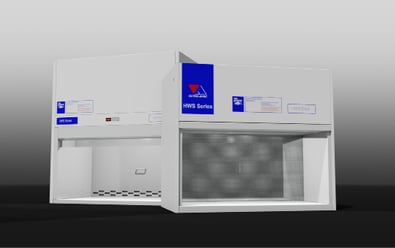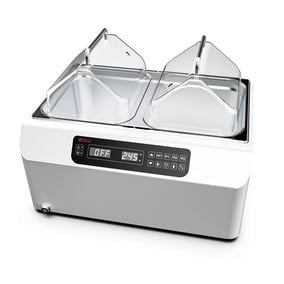
Laminar flow cabinets, also known as laminar flow hoods or clean benches, are specialized equipment used in laboratories, medical facilities, and other controlled environments to provide a clean and sterile work area for various tasks. These cabinets maintain a controlled flow of filtered air to minimize the risk of contamination and ensure a sterile environment for processes like cell culture, sample preparation, or handling of sensitive materials. Themoline offers the AES range of laminar flow cabinets. These are made and designed in Australia.
Laminar flow cabinets can have either horizontal or vertical airflow, and the choice between the two will depend on the task's requirements being performed and the type of contamination control needed. It must be noted that laminar flow cabinets are used to prevent contamination of the samples or equipment inside and do not provide any protection for the user from aerosols of hazardous material. If user protection is also needed, then other styles of cabinet can be used, such as Class I, Class II or even cytotoxic safety cabinets.
Horizontal Flow Cabinets:
In horizontal flow cabinets, the filtered air is blown from the back of the cabinet and flows horizontally toward the front opening where the user works.
These cabinets are suitable for tasks that require protection for the samples or materials being handled. They offer protection against contamination of the samples from the environment or the operator.
Horizontal flow cabinets are commonly used for applications like preparing microbiological cultures, handling non-hazardous samples, and other tasks where sample protection is crucial.
PROS:
- Horizontal flow cabinets are less prone to have the user's hands interrupt the laminar flow of clean air.
- Often better product protection.
- Usually, a larger opening (no sash)
- With samples closer to the filters, there is less chance of contamination from gloves and hands as they are mostly downstream of the samples.
CONS:
- Continual air being blown into the operator's face (this is a comfort thing as hazardous materials should never be used in a laminar flow cabinet).
- Large items may disrupt the airflow or even contaminate samples in front of them.
- The workspace is slightly smaller than the vertical flow cabinet due to the filters being located at the back of the cabinet.
Vertical Flow Cabinets:
In vertical flow cabinets, the filtered air is blown from the top of the cabinet and flows vertically downward toward the work surface.
These cabinets provide a cleaner and more sterile environment for the work surface, as any particles generated by the user are quickly pushed downward and away from the samples or materials.
Vertical flow cabinets are often used in applications that require a higher level of cleanliness, such as working with sensitive materials, fine electronics assembly, or tasks where protection of the work area from the user is essential.
PROS:
- Horizontal flow cabinets are less prone to have the user's hands interrupt the laminar flow of clean air.
- It has some inherent operator protection but should not be relied upon.
- Usually, a deeper workspace.
- The cabinet is not as physically deep, allowing for a slightly smaller bench to house it.
- Cross-contamination is less so items on the work surface and less turbulence from large items or samples.
CONS:
- More turbulent air at the work surface.
- Smaller opening to the workspace.
- Stacking items will disrupt the airflow.
- Taller cabinets, in general, require greater height clearance, and changing filters can be more difficult.
Which to choose:
The choice between horizontal and vertical flow cabinets should be based on the specific tasks, the level of contamination control required, and any regulatory guidelines that apply to your work. Both types of cabinets play a crucial role in maintaining clean and controlled work environments for various applications.
Personal preference and comfort can also play a major role in the choice.
If you have any questions at all, don't hesitate to get in touch with our customer service team.






